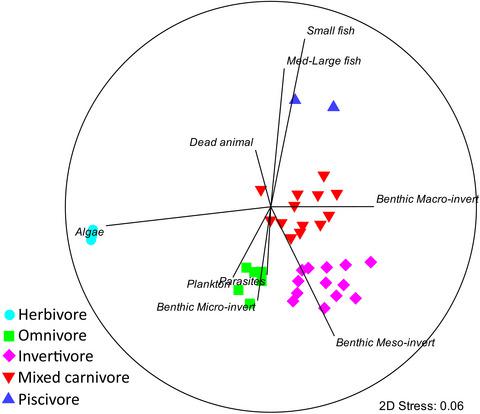当前位置:
X-MOL 学术
›
Austral Ecol.
›
论文详情
Our official English website, www.x-mol.net, welcomes your
feedback! (Note: you will need to create a separate account there.)
Using qualitative data to classify reef fishes into dietary guilds
Austral Ecology ( IF 1.6 ) Pub Date : 2021-06-16 , DOI: 10.1111/aec.13072 Odette R. Howarth 1 , Libby Liggins 1 , Adam N. H. Smith 1
Austral Ecology ( IF 1.6 ) Pub Date : 2021-06-16 , DOI: 10.1111/aec.13072 Odette R. Howarth 1 , Libby Liggins 1 , Adam N. H. Smith 1
Affiliation

|
Classification of species into dietary guilds that consume similar food resources can provide a useful framework for understanding ecosystem function. Traditionally, species were assigned to guilds qualitatively rather than quantitatively, largely due to a lack of detailed data on the diets of many species. More recently, detailed dietary data are collected and analysed quantitatively to produce a classification, but the collection of such data is intensive and usually limits a study to a small number of species. Here, we show that quantitative classifications can be built from qualitative data sourced from natural history texts and expert knowledge for well-known fauna. We collected available data on the presence or absence of nine broad food item categories in the diets of 158 species of fish observed on New Zealand’s shallow rocky reefs. These data were analysed using multivariate statistical methods pioneered by K. R. Clarke and colleagues for use with site-by-species ecological survey data. In particular, we adapted a taxonomic dissimilarity measure to take into account a natural hierarchy of the food items, so that, for example, the diets of two species that consume different types of invertebrates were considered more similar to each other than those of, say, invertivores vs piscivores, or carnivores vs herbivores. Our analysis produced five distinct dietary guilds: Herbivore (9 species), Omnivore (11), Invertivore (80), Macro-carnivore (52) and Piscivore (6). We suggest that invertivores, which made up around half of the species, are likely underrepresented in many studies due to the exclusion of smaller species. The approach of collecting broadly available qualitative data and applying modern multivariate quantitative methods to produce more inclusive dietary classifications may be usefully applied to other well-known taxonomic groups for which detailed data are scarce.
中文翻译:

使用定性数据将珊瑚鱼分类为饮食行会
将物种分为消耗相似食物资源的饮食行会,可以为理解生态系统功能提供一个有用的框架。传统上,物种被定性地而不是数量地分配给行会,主要是由于缺乏许多物种饮食的详细数据。最近,详细的饮食数据被收集并定量分析以产生分类,但此类数据的收集是密集的,并且通常将研究限制在少数物种。在这里,我们表明可以从自然历史文本和知名动物群的专家知识的定性数据中建立定量分类。我们收集了有关在新西兰浅岩礁观察到的 158 种鱼类的饮食中是否存在九种广泛食物类别的可用数据。这些数据使用由 KR Clarke 及其同事开创的多变量统计方法进行分析,这些方法与逐个物种的生态调查数据一起使用。特别是,我们调整了分类差异度量以考虑食品的自然层次结构,因此,例如,食用不同类型无脊椎动物的两个物种的饮食被认为比其他物种的饮食更相似,例如, 逆行者对食肉动物,或食肉动物对食草动物。我们的分析产生了五个不同的饮食行会:草食动物(9 种)、杂食动物(11 种)、反食动物(80 种)、大型食肉动物(52 种)和鱼食动物(6 种)。我们认为,由于排除了较小的物种,占该物种一半左右的倒食动物在许多研究中的代表性不足。收集广泛可用的定性数据并应用现代多元定量方法来产生更具包容性的饮食分类的方法可能有用地应用于详细数据稀缺的其他知名分类群。
更新日期:2021-08-25
中文翻译:

使用定性数据将珊瑚鱼分类为饮食行会
将物种分为消耗相似食物资源的饮食行会,可以为理解生态系统功能提供一个有用的框架。传统上,物种被定性地而不是数量地分配给行会,主要是由于缺乏许多物种饮食的详细数据。最近,详细的饮食数据被收集并定量分析以产生分类,但此类数据的收集是密集的,并且通常将研究限制在少数物种。在这里,我们表明可以从自然历史文本和知名动物群的专家知识的定性数据中建立定量分类。我们收集了有关在新西兰浅岩礁观察到的 158 种鱼类的饮食中是否存在九种广泛食物类别的可用数据。这些数据使用由 KR Clarke 及其同事开创的多变量统计方法进行分析,这些方法与逐个物种的生态调查数据一起使用。特别是,我们调整了分类差异度量以考虑食品的自然层次结构,因此,例如,食用不同类型无脊椎动物的两个物种的饮食被认为比其他物种的饮食更相似,例如, 逆行者对食肉动物,或食肉动物对食草动物。我们的分析产生了五个不同的饮食行会:草食动物(9 种)、杂食动物(11 种)、反食动物(80 种)、大型食肉动物(52 种)和鱼食动物(6 种)。我们认为,由于排除了较小的物种,占该物种一半左右的倒食动物在许多研究中的代表性不足。收集广泛可用的定性数据并应用现代多元定量方法来产生更具包容性的饮食分类的方法可能有用地应用于详细数据稀缺的其他知名分类群。











































 京公网安备 11010802027423号
京公网安备 11010802027423号